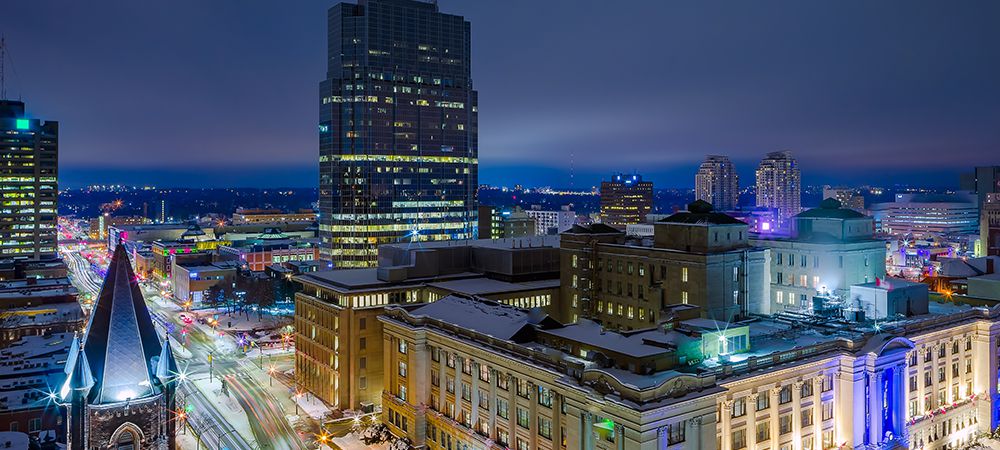
Living in London, Ontario
Living in London: A Complete Guide
If you’re a newcomer to London, Ontario or considering a move, you probably have some questions about life in the Forest City. What is it like to live in London? Is it affordable? What is transportation like? What are the best neighbourhoods? Why should I choose London to work and raise a family?
Let’s just put it out there that we love London! We think it’s a great city to live in!
Like all cities, London has its pros and cons, and there are important things to know before you commit to a new place of homeIn this article, we’ll explore the most commonly asked questions about London, Ontario:
- What Are The Basics About London, Ontario?
- Where is London located in Canada?
- What Is The Best Wayto Get Around in London?
- What Is London Weather Like?
- Where Should I Live? Downtown or the Suburbs?
- What Is The Cost of Living in London?
- How Do I Find Work in London?
- What Things Are There To Do In London?
Everything You Need To Know About Living in London, Ontario
The Basics About London Ontario
London Ontario Population – 511,000 (2021)
Size – 420.6 sq km
Median Age – 39.7 years
Languages Known by the Population
- English – 98.3%
- French – 7.4%
- Arabic – 3.8%
- Spanish 3.5%
- Mandarin 1.8%
Religion Practiced by the Population
- Christian Faiths – 62.8%
- Islam – 4.4%
- Buddhism – 0.8%
- No religious affiliation – 29.9%
Schools
Junior Kindergarten through Grade 12 students study primarily at publicly funded schools. Post-secondary school options include six universities and colleges. The two largest are Western University https://www.uwo.ca/ and Fanshawe College. https://www.fanshawec.ca/

Where is London in Canada?
London is in Canada, located in the province of Ontario. London’s location is almost exactly halfway between Windsor and Toronto in Southwestern Ontario. It’s directly between Sarnia on the west and Niagara Falls on the east. This conveniently places London between Canada’s largest city (Toronto) and three of its busiest international border crossings.
Three of Ontario’s main highways can easily be accessed from anywhere in London:
- The 401 runs from the Windsor / Detroit border all the way to the Quebec border
- The 402 begins at the Sarnia border crossing and ends just south of London
- The 403 runs east out of London and ends in Hamilton with easy access to the Niagara region’s connecting highways
How to Get Around in London, Ontario
Many London residents would tell you that in order to enjoy all London has to offer, you’ll want to have your own personal car. While London does have a public bus service, it doesn’t quite access the entire city like it might larger metropolitan cities.
If you don’t have your own vehicle, consider living downtown or check out the London Transit map before committing to housing. Need more help? Check out this helpful guide.
Other transportation options:
Taxi – There are many options in the city for taxis that you can either hail in the downtown core or call to arrange in other neighbourhoods.
Uber – For an alternative to taxi service, try Uber, a car service that allows you to grab a ride in the driver’s personal vehicle. Usually known for being cleaner and more comfortable than a taxi, Uber is also completely cashless.
ViaRail – Want to head out of town? You can use ViaRail to travel to almost every major city in the country including Windsor, Sarnia, and Toronto.
Need to fly away? London International Airport is available to fly you to plenty of locations in Canada, the USA, and abroad. Many of London’s flights transit through Toronto or Montreal before heading to their final destinations, but it’s still very helpful to have an airport so close!
What Is London’s Weather Like?
London is a true four-season city. Residents have the pleasure of experiencing distinct elements of winter, spring, summer, and fall. Average temps can range from about -9 to 26°C.
While London is close in proximity to Toronto, it tends to get more snowfall each year. London is situated in between the Great Lakes and experiences about four snowstorms each winter season.
London residents experience beautiful spring months with blossoming trees and comfortably warm days. Fall brings what is known as sweater weather; days that are comfortably cool when you have on just a sweater, and before the chill of winter sets in. Summer can be hot, but not as warm as Toronto, and is generally tolerable, around 25°C.
If you’ve never experienced winter you may be slightly shocked by the snowfall, but compared to many Canadian cities, London has shorter winter seasons. Overall, residents, including immigrants, find London’s weather tolerable. Just make sure you buy some good winter gear, and if you’re new to winter weather, take a driving lesson.

Where Should I Live? Downtown or the Suburbs?
London is growing, but it’s still in many ways considered a smaller Canadian city. One side-effect of this is a lack of great transportation options. Unlike larger cities, London doesn’t have a local train service or subway, and its bus system, while getting better all the time, still has plenty of room for improvement.
If you need to use local public transit, you may want to stay in the downtown area. Compared to the suburbs, downtown offers more access to conveniences like grocery stores and banks. If you’re a young professional who doesn’t yet own a car or who really enjoys city life, the downtown district is likely for you.
If you’re a student at Western University, you might want to try to stay on the Northside of downtown. If you’re studying at Fanshawe, you’ll likely want to find a place East of downtown.
London has plenty of family-friendly neighbourhoods. Among our favourites are Byron, Foxfield, Summerside, and Masonville, all known for their great homes, community parks, excellent schools, and conveniences like shopping centres. These communities also have condos, so if you enjoy the suburbs but don’t want to have to worry about cutting the grass, you can have the best of both worlds in London.
Cost of Living in London
Cost of living is a calculated number that helps you understand how much money it costs to live in a specific city. It takes into account basic living expenses, like housing, food, transportation, child care, taxes, etc. Cost of living doesn’t include extras like vacations or other unnecessary spending.
London is affordable when compared with other major cities in Canada and the world. There are affordable housing options available if you need housing assistance. See more information on London.ca https://london.ca/living-london/community-services/homeless-prevention-housing/social-housing
According to numbeo.com, the cost of living in London break down looks like this:
- A family of four’s estimated monthly costs are $4,067 without rent.
- A single person’s estimated monthly costs are $1,132 without rent.
Rent prices for a 3-bedroom apartment are hovering around $2,300, with a 1-bedroom sitting at $1,300, according to Zumper.com. By comparison, the national average rent for a 1 bedroom apartment across the country is $1,326.79, so London is on par with most other cities.
How to Find Work in London
Information London is a resource that you will find helpful if you move to London, and even has a section about how to find a job in the city. Here, you can find information about the London Employment Help Center, a service that works with anyone looking to find work who is struggling. At the Help Center, you can also find services specifically for you if you’re disabled or if you need to access government grants. You can find advocacy services if you require government benefits and attend one-on-one or group employment workshops if you need help with certain employment skills.
Pathways Employment Help Center is a non-profit operating in the city where you can find plenty of assistance finding a job. Their objective is to help potential employees improve skills and overcome barriers that prevent them from finding meaningful work.
Things to do in London
London is a beautiful city to live in, especially if you love being outside. With plenty of parks, rivers, conservation areas, and nature trails, there’s a lot to explore.
Springbank Park is a 300-acre park along the Thames River and contains over 30 km of walking trails that are accessible during every season. You can also take your little ones to Storybook Garden, housed inside the park.
Covent Market is an indoor local food and craft market full of local vendors where you can pick up freshly grown food. London has other local street markets and shops which locals love.
Catch a London Knights game at Budweiser Gardens.
Spend hot summer days at East Park and cool off in the wave pool. Hit the water slides, play a round on their golf course, or send the big kids over to the go-carts for a fun afternoon.
London has plenty to keep of amenities you busy including great nightlife, restaurants, shopping malls, festivals, and sporting events! Read more here.
Want to learn more about London life? Let our friendly real estate agents show you around and help you find the perfect house near whatever amenities you need to live, work, and play. Justo is committed to providing you with superior service, putting customer satisfaction at the heart of everything we do. Contact Us Today!

Read More
Connect With Us
Connect with our friendly Client Ambassadors and find the best Agent to match your needs
Call us at 1-647-794-0064
Join Our Team |Become a Partner


